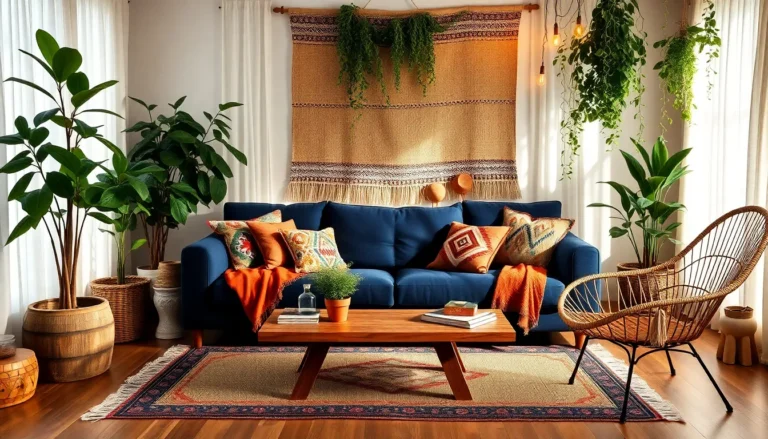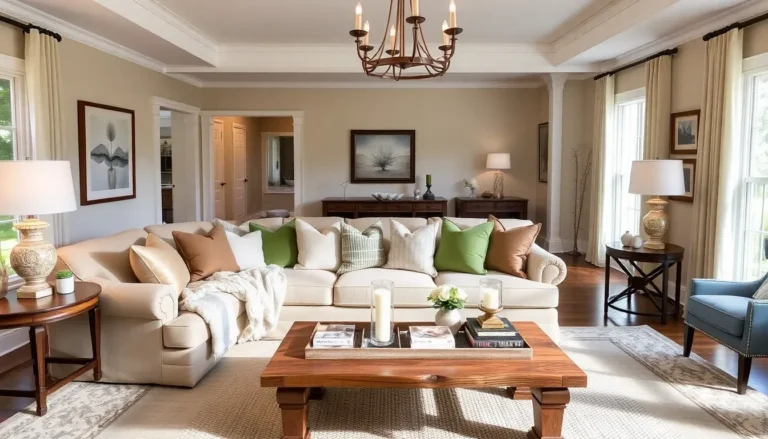Table of Contents
ToggleSmall living rooms might seem like a design challenge, but they’re actually a canvas for creativity. Who needs a sprawling space when you can transform a cozy nook into a stylish sanctuary? With the right tricks up your sleeve, even the tiniest rooms can pack a punch, blending comfort and flair.
Understanding Small Living Rooms
Small living rooms convey both character and warmth, making them ideal for creating inviting spaces. Embracing the unique attributes of compact areas enhances design possibilities and livability.
Characteristics of Small Living Rooms
Small living rooms often feature limited square footage, presenting distinct characteristics. Furniture layout plays a crucial role in maximizing space efficiency. Natural light, when optimized, can create an airy atmosphere. Color schemes tend to favor lighter shades, which visually expand the room. Style choices frequently blend minimalism with multifunctional pieces, ensuring that every item serves a purpose.
Benefits of Small Living Rooms
Small living rooms offer numerous advantages that enhance overall comfort. Lower maintenance requirements result from reduced space, simplifying cleaning routines. Cozy settings foster intimate gatherings, promoting connection among family and friends. Budget-friendly options arise due to the limited quantity of furniture and decor needed. Lastly, small spaces encourage creative design solutions, allowing for personalization while showcasing individual tastes.
Design Tips for Small Living Rooms

Small living rooms present unique opportunities for design. Effective strategies help maximize space while maintaining style.
Color Schemes and Textures
Light colors create an illusion of spaciousness. Soft whites, pale grays, and pastel hues expand the room’s apparent size. Incorporating various textures adds depth, preventing a flat appearance. Consider using different fabrics like linen for curtains and soft cotton for throw pillows. Varying textures enhances visual interest, making the space feel more inviting. Mirrors can reflect light and amplify brightness. Integrating a few statement pieces, such as a textured rug or an art piece, maintains personality while adhering to a cohesive color palette.
Furniture Selection and Arrangement
Choosing multifunctional furniture optimizes small spaces. Sofas with built-in storage serve dual purposes and save room. Select furniture proportional to the area; oversized pieces generally overwhelm. Arrange seating to foster conversation without blocking pathways. Consider floating furniture away from walls to create depth and a more open feel. A round coffee table enhances flow and eases movement. Positioning furniture strategically enhances the room’s usability while keeping it visually appealing.
Essential Accessories for Small Living Rooms
Selecting the right accessories enhances the charm and functionality of small living rooms. Thoughtfully chosen items contribute to both style and comfort.
Multi-Functional Furniture
Multi-functional furniture maximizes usability in limited spaces. Sofa beds provide seating during the day and convert into beds at night, offering versatility. Storage ottomans serve as footrests, extra seating, and hidden storage for blankets and games. Nesting tables create a flexible surface that can expand when needed, yet tuck away neatly. Compact dining tables with drop leaves accommodate guests without overwhelming the room. Prioritize pieces that adapt and optimize every square inch of the living area.
Decorative Elements
Decorative elements add personality and style while keeping a space feeling open. Wall art draws the eye upwards, creating a sense of height in small living rooms. Indoor plants introduce life and freshness, boosting air quality. Rugs define areas without blocking sightlines, enhancing visual depth. Light fixtures like wall sconces or pendant lamps save floor space and create an inviting glow. Mirrors amplify light and open up the room, giving the illusion of spaciousness. Choose accessories that complement the existing decor and reinforce a cohesive aesthetic.
Creating an Illusion of Space
Small living rooms can effectively utilize design techniques to create an illusion of space. By focusing on elements like mirrors and strategic layout choices, compact areas transform into visually appealing, open environments.
Mirrors and Lighting Techniques
Mirrors serve as valuable assets in small living rooms. They reflect light and create depth, making the space feel larger. Positioning mirrors opposite windows maximizes natural light penetration. Selecting statement mirrors adds a decorative touch while enhancing the area’s dimension. Complementing mirrors with layered lighting, such as floor lamps and wall sconces, improves the overall ambiance. These lighting solutions create softer, more inviting atmospheres while highlighting features of the room.
Open Layout Ideas
Open layouts promote airflow and movement within small living spaces. Consider using furniture arrangements that encourage flow, such as floating sofas or chairs away from walls. These arrangements keep pathways clear and ensure easy navigation. Utilizing a unified color palette throughout the room creates visual continuity, enhancing the perception of space. Choosing low-profile furniture prevents blockage of sightlines, which contributes to an airier feel. Accessories like lightweight curtains can eliminate visual barriers and maintain openness, ultimately reinforcing a spacious atmosphere.
Small living rooms present unique opportunities for creativity and personal expression. By embracing design strategies that prioritize functionality and style, anyone can transform a compact space into a warm and inviting retreat. The right furniture choices and layout can enhance usability while maintaining a sense of openness.
Incorporating light color schemes and strategic lighting can further amplify the feeling of spaciousness. Thoughtful accessories and multifunctional pieces not only add personality but also optimize the limited space available. Ultimately, small living rooms can reflect individual tastes and foster intimate gatherings, proving that size doesn’t dictate comfort or style.








